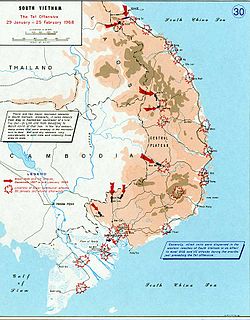Tet Offensive
This is the sighted version that was marked on April 7, 2021. There is 1 pending change that needs to be sighted.
Tet Offensive
Part of: Vietnam War

Tet Offensive - 29 January to 25 February 1968
Battles and Operations of the
Vietnam War
Battle of Tua Hai (1960) - Battle of Ap Bac (1963) - Battle of Nam Dong (1964) - Tonkin Incident (1964) - Operation Flaming Dart (1965) - Operation Rolling Thunder (1965-68) - Battle of Dong Xoai (1965) - Battle of the Ia-Drang-.Valley (1965) - Operation Crimp (1966) - Operation Hastings (1966) - Battle of Long Tan (1966) - Operation Attleboro (1966) - Operation Cedar Falls (1967) - Battle of Hill 881 (1967) - Battle of Dak To (1967) - Battle of Khe Sanh (1968) - Tet-Offensive (1968) - Battle of Huế (1968) - Operation Speedy Express (1968/69) - Operation Dewey Canyon (1969) - Battle of Hamburger Hill (1969) - Operation MENU (1969/70) - Operation Lam Son 719 (1971) - Battle of FSB Mary Ann (1971) - Battle of Quảng Trị (1972) - Operation Linebacker (1972) - Operation Linebacker II (1972) - Battle of Xuan Loc (1975) - Operation Frequent Wind (1975).
The Tet Offensive was a series of offensive military operations by the North Vietnamese Army and Viet Cong between 30 January and 23 September 1968 as part of the Vietnam War. It began as a surprise attack on the day after or on Vietnamese New Year, Tết Nguyên Đán. In 1968, the New Year festival took place as early as January 29 in North Vietnam and as late as January 30 in South Vietnam. The reason for the difference was that the time zone UTC + 7 hours was decisive for the former and the longitude of Beijing for the latter.
Background
By the end of the 1960s, the adversaries in the Vietnam War were highly armed. By the beginning of 1968, the USA had increased its troop contingent to over half a million soldiers. Nevertheless, it had not succeeded in decisively defeating the Vietcong guerrillas, because North Vietnam had been considerably rearmed through arms aid from the People's Republic of China and the Soviet Union.
Attack
The Vietcong attack on January 30 and in the following days came as a complete surprise to the South Vietnamese and the Americans, especially since many South Vietnamese soldiers were on holiday leave. The North Vietnamese Army had launched an offensive against the American base at Khe Sanh near the demilitarised zone shortly before, so many thousands of elite US soldiers had been moved there to defend it, as the American military leadership feared a second Điện Biên Phủ. The attack was on the broadest front with more than 80,000 troops and at more than 100 points simultaneously. Among other things, the Viet Cong succeeded in capturing the old imperial city of Huế and occupying the citadel there (Battle of Huế). In addition, the US embassy in the centre of Saigon was attacked at the same time by shock troops with great propaganda effect, although it was not possible to occupy it. Much stronger attacks took place in and near Saigon on the airfield and the headquarters of General William Westmoreland and the South Vietnamese military. The Viet Cong and their allies used extreme brutality against perceived supporters of the South Vietnamese government. In the city of Huế alone, between 2,000 and 6,000 people were executed during the three weeks of Viet Cong rule, including foreign doctors, priests, and children. Some of the dead found later were mutilated, and some were apparently buried alive.
It took the Americans only a short time to rally and fight back. The very next morning they attacked the North Vietnamese with 5,000 men, and within five days the North Vietnamese troops had been driven back again. The fighting in Huế was harder, longer and more costly, but here too it ended after a good month with the retreat of the North Vietnamese and the Vietcong.
Search within the encyclopedia